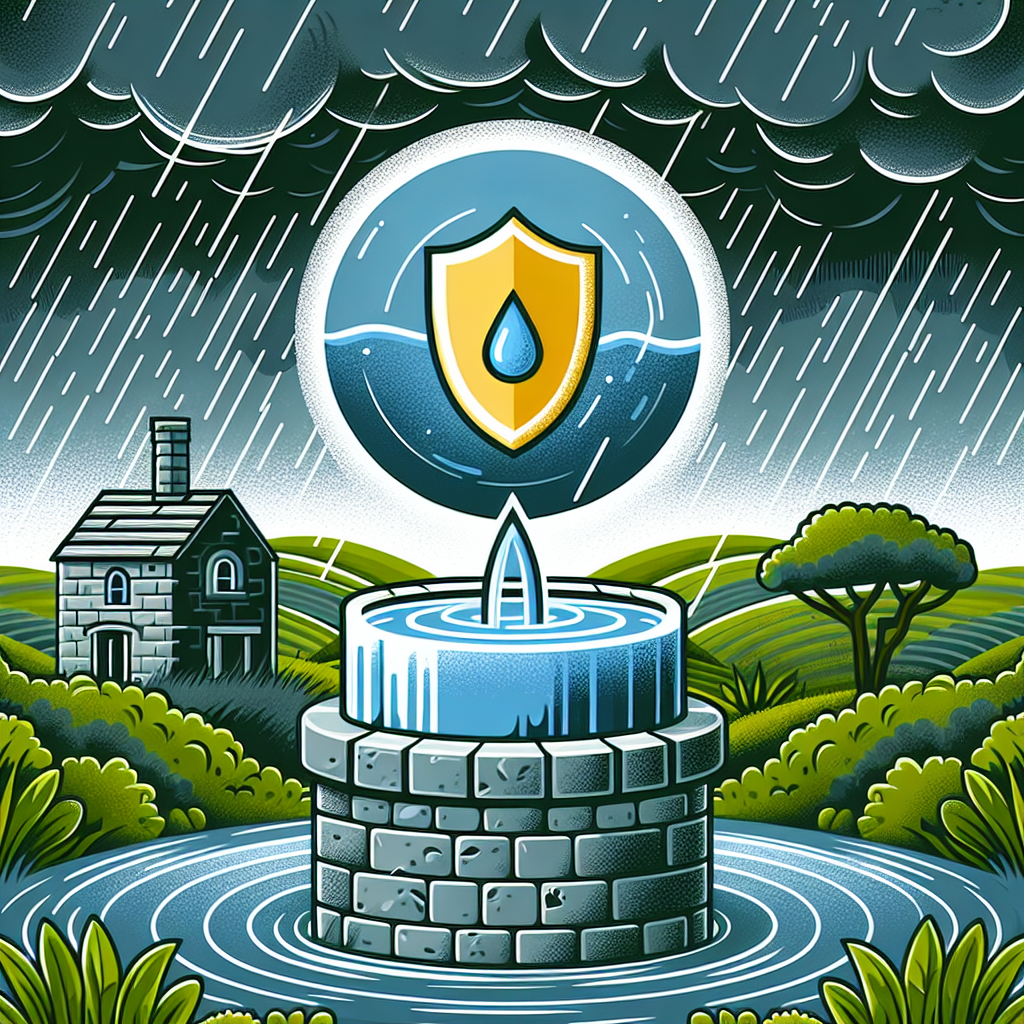Are you living in an area with heavy rainfall and relying on well water for your daily needs? If so, you might have some concerns about the safety of your water supply. This article aims to provide you with practical tips and guidance on how to address safety concerns associated with well water in regions prone to heavy rainfall. From understanding the potential risks to implementing effective filtration systems, we’ve got you covered so you can enjoy clean and safe water without worry.

Understanding the Safety Concerns
When it comes to well water in regions with heavy rainfall, there are several safety concerns that need to be addressed. Understanding these concerns is the first step in ensuring the safety and quality of your well water.
Sources of Contamination
One of the main sources of contamination in well water is surface water runoff. As heavy rainfall occurs, water can wash over the ground and carry various contaminants, such as fertilizers, pesticides, and bacteria, into your well. Other sources of contamination include improperly constructed or maintained wells, septic systems, and nearby industrial activities.
Potential Health Risks
Contaminated well water poses a significant risk to your health. Consuming water contaminated with bacteria, viruses, or chemicals can lead to various illnesses, including gastrointestinal issues, infections, and even long-term health problems. It is essential to address safety concerns promptly to prevent these health risks.
Importance of Addressing Safety Concerns
Addressing safety concerns related to well water in regions with heavy rainfall is crucial for several reasons. First and foremost, it helps protect your health and the health of your family. By ensuring the safety and quality of your well water, you can reduce the risk of waterborne illnesses and potential long-term health effects.
Additionally, addressing safety concerns can also help protect the environment. Contaminated well water can seep into the ground and pollute nearby water bodies or aquifers. This can harm aquatic life and disrupt delicate ecosystems. By taking steps to address safety concerns, you contribute to the overall well-being of the environment.
Inspecting and Maintaining the Well
Regular inspection and maintenance of your well are vital for maintaining the safety and quality of your well water. Here are some crucial steps to follow:
Regular Inspection
Schedule regular inspections of your well to identify any potential issues or signs of contamination. A professional well inspector can assess the condition of your well, check for cracks or leaks, and ensure that all components are functioning correctly.
Testing for Bacterial Contamination
Regular testing for bacterial contamination is essential to ensure the safety of your well water. You can contact a certified laboratory to have your water tested for bacteria such as E. coli and coliform. If any contamination is detected, prompt action should be taken to disinfect the well and prevent further health risks.
Measuring Water Levels
Monitoring the water levels in your well is essential to assess its overall health and prevent potential problems. If the water level drops significantly, it may indicate a problem with the water source or excessive groundwater pumping. By monitoring water levels, you can take appropriate action to maintain the sustainability of your well.
Maintaining Proper Well Covers
Well covers play a crucial role in preventing surface water runoff and contaminants from entering your well. Ensure that your well covers are securely in place and properly sealed. Regularly inspect and maintain the well covers to prevent any potential issues and keep your well protected.
Preventing Surface Water Runoff
Preventing surface water runoff is a crucial step in addressing safety concerns related to well water in regions with heavy rainfall. Here are some effective measures you can take:
Creating Slopes and Drainage Channels
To prevent surface water from collecting near your well, create slopes and drainage channels around the well site. By directing water away from the well, you can reduce the risk of contamination.
Diverting Rainwater Away from Wells
Install gutters, downspouts, and extensions to direct rainwater away from your well. This helps prevent surface water runoff from entering the well and potentially contaminating the water source.
Installing Rain Barrels
Installing rain barrels to collect rainwater can help reduce the amount of surface water runoff near your well. Instead of running off into the ground, the rainwater can be collected and used for non-potable purposes, such as watering plants or cleaning.
Implementing Rain Gardens
Rain gardens are designed to capture and filter rainwater, allowing it to infiltrate into the ground slowly. By implementing rain gardens near your well, you can reduce the volume of surface water runoff and help protect your well water from contamination.
Protecting the Wellhead
The wellhead, or the top portion of the well, is a critical area that needs to be protected from contaminants. Here are some measures to consider:
Constructing a Wellhead Protection Area
Create a wellhead protection area around your well to prevent potential contamination. This area should be free from any potential pollutant sources, such as septic systems, fertilized areas, or chemical storage facilities.
Ensuring Adequate Distance from Contaminant Sources
When constructing a well or assessing its location, ensure that there is a sufficient distance between the well and potential sources of contamination. Regulations may vary, but a general guideline is to have a minimum of 50 feet between the well and septic systems or livestock areas.
Controlling Access to the Well
Limiting access to your well is essential for preventing accidental contamination. Consider installing a lockable well cap or placing a fence around the well to prevent unauthorized access and potential tampering.
Installing Protective Barriers
Installing protective barriers, such as concrete pads or curbing, around your well can provide an additional layer of protection against surface water runoff. These barriers help prevent contaminants from flowing into the well or pooling around the wellhead.

Addressing Groundwater Contamination
Understanding the local geology and aquifers is crucial for addressing groundwater contamination. Here are some steps you can take:
Understanding Local Geology and Aquifers
Research and understand the geology of your area to determine the characteristics of the aquifers that supply your well water. This information can help identify potential sources of groundwater contamination and guide remediation efforts if necessary.
Monitoring Groundwater Quality
Regularly monitor the quality of your groundwater by conducting water tests. This can help identify any changes or trends in contaminant levels and provide early warning signs of potential contamination issues.
Identifying Potential Contaminant Sources
Survey the surrounding area to identify potential sources of groundwater contamination. These may include agricultural activities, industrial sites, or improper waste disposal practices. By knowing the possible sources, you can take appropriate measures to prevent or minimize contamination.
Implementing Remediation Measures
If groundwater contamination is detected, it is crucial to implement appropriate remediation measures. This may involve working with environmental professionals, local authorities, or specialized contractors to address the specific contaminant and develop an effective remediation plan.
Investing in Water Treatment Systems
Investing in a reliable water treatment system can provide an additional layer of protection for your well water. Here are some key considerations:
Choosing the Right Water Treatment System
Select a water treatment system that is specifically designed to address the identified contaminants in your well water. Consult with water experts or professionals to determine the most suitable treatment system for your needs.
Filtration Methods and Technologies
Filtration is an effective method for removing various contaminants from your well water. Depending on the specific contaminants present, consider using activated carbon filters, reverse osmosis systems, or other filtration technologies to enhance the safety and quality of your water.
Disinfection Methods
Disinfection is crucial for killing bacteria, viruses, and other harmful microorganisms that may be present in your well water. Common disinfection methods include chlorination, ultraviolet (UV) disinfection, and ozonation.
Maintaining and Testing Treatment Systems
Regular maintenance and testing of your water treatment system are essential to ensure its continued effectiveness. Follow the manufacturer’s recommendations for maintenance, filter replacements, and system checks. Regularly test your treated water to verify the system’s performance and confirm that it meets the required safety standards.

Educating and Raising Awareness
Educating yourself and others about well water safety is essential for addressing safety concerns. Here are some ways to promote awareness:
Understanding the Risks and Best Practices
Take the time to educate yourself about the risks associated with well water and the best practices for maintaining water safety. Stay informed about local regulations and guidelines to ensure compliance.
Promoting Safe Well Water Use
Spread awareness about safe well water use by sharing information with friends, family, and neighbors. Encourage them to follow recommended practices, such as regular testing, proper well maintenance, and prevention of surface water runoff.
Providing Resources and Information
Make resources and information on well water safety readily available to your community. This can include pamphlets, brochures, or online resources that explain potential risks, preventive measures, and treatment options.
Collaborating with Local Authorities and Organizations
Engage with local authorities, health departments, and organizations to collaborate on initiatives that promote well water safety. Join community programs or workshops that focus on educating residents about well water concerns.
Rainwater Harvesting as an Alternative
In regions with heavy rainfall, rainwater harvesting can be a viable alternative or supplement to well water. Consider the following:
Benefits of Rainwater Harvesting
Rainwater harvesting offers several benefits, including reducing strain on wells, conserving groundwater resources, and providing an additional water source during dry periods. Additionally, harvested rainwater is typically free from the contaminants that may be present in well water.
Collecting and Safely Storing Rainwater
Collect rainwater from rooftops or other suitable surfaces using gutters and downspouts. Direct the collected rainwater into storage tanks or barrels. Ensure that the storage containers are properly sealed and protected from external contaminants.
Using Rainwater for Non-Potable Purposes
Rainwater can be used for various non-potable purposes, such as irrigation, watering plants, or cleaning. By utilizing rainwater for these purposes, you can reduce the demand on your well water and minimize the risk of contamination.
Supplementing Well Water with Rainwater
Consider incorporating rainwater into your well water system as a supplemental source. This can help reduce the reliance on the well during heavy rainfall periods and ensure a sustainable water supply throughout the year.

Emergency Preparedness
Being prepared for emergencies is crucial for ensuring the safety of your well water. Here are some important steps to take:
Developing a Contingency Plan
Develop a contingency plan that outlines the steps to be taken in the event of an emergency, such as severe flooding or contamination. Include information on alternative water sources, emergency contacts, and disinfection procedures.
Having Emergency Water Sources
Maintain emergency water sources in case your well water becomes compromised. This can include storing bottled water or having access to alternative water supplies, such as nearby water distribution centers or community wells.
Monitoring Local Weather and Rainfall
Stay informed about local weather conditions and rainfall patterns. Being aware of heavy rainfall events or severe weather warnings can help you take preventive measures to protect your well water and respond quickly in case of emergencies.
Knowing Proper Disinfection Techniques
Familiarize yourself with proper disinfection techniques in case of contamination. This knowledge can be invaluable during emergencies when quick action is necessary to ensure the safety of your well water.
Engaging Professional Assistance
Seeking professional assistance is essential when addressing safety concerns related to well water. Consider the following:
Consulting Water Experts
Consulting water experts, such as environmental consultants or hydrogeologists, can provide valuable insights and guidance on addressing safety concerns. These professionals can help assess your well system, identify potential risks, and recommend appropriate solutions.
Hiring Certified Well Contractors
When it comes to well construction, repairs, or maintenance, hire certified well contractors with specialized expertise. These professionals have the knowledge and training to ensure the proper installation and maintenance of your well system.
Seeking Government Programs and Support
Explore government programs or initiatives that provide support for well owners in regions with heavy rainfall. These programs may offer financial assistance, education resources, or technical support to help address safety concerns and promote well water quality.
Understanding Permitting and Regulations
Ensure compliance with local permitting requirements and regulations related to well construction and maintenance. Understanding the regulatory framework applicable to your area will help you make informed decisions and maintain the safety of your well water.
By understanding and addressing safety concerns related to well water in regions with heavy rainfall, you can safeguard your health, protect the environment, and ensure a reliable supply of clean and safe water for you and your family. Take proactive steps, seek professional assistance when needed, and stay informed about best practices to maintain the safety and quality of your well water.

